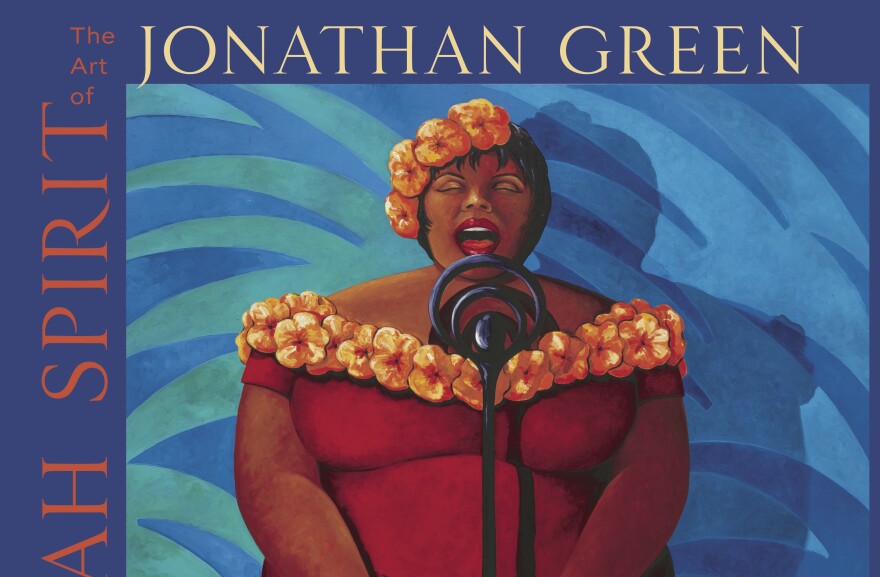It’s hard not to notice Jonathan Green, even in a crowd.
Vibrantly dressed in an emerald green jacket with floral details, he pops like the subjects of his colorful paintings collected in a new book called, “Gullah Spirit”.
Green mingles with fans and potential buyers during the book’s launch at the Gibbes Art Museum in Charleston. The crowd is eclectic, and many are eager to pose for a picture with the 66-year-old who after decades of work has become internationally known.
Hours before the museum party, Green is gracious with his time as he talks about the book at his downtown home, greeting me atop a spiral staircase. His eyes and smile are just as engaging dressed down in a black t-shirt.
“I’m amazed they chose this painting and it’s titled a time for love,” says Green. “Now doesn’t that say it all?”
Green reflects on the cover.
It depicts a full-figured woman with warm, brown skin adorned in a brilliant red, flowing dress. Her eyes are gently closed. Her mouth open before a microphone. You can almost hear a soulful song.
Like many of the people Green paints, the elegant woman is someone he knows.
“This would be Davies is her name and she was a neighbor, like a cousin,” says Green.
“So, in the Black community, if you’re a neighbor, you’re a cousin,” laughs Green.

Green grew up with lots of cousins. He was the second of seven siblings raised by his grandmother in the Beaufort County community of Gardens corner, named for a plantation owner.
There, families worked together living off the land. They fished and farmed, and rarely went to a store. Green even learned a unique language from his elders.
Today, these direct descendants of slaves who maintained their West African traditions are known as Gullah. But until his twenties, Green had never heard the word before.
“We never referred to ourselves as anything other than being Black or being Negro or being colored,” says Green.
“When I heard the connection and learned it was directly connected to Africa, then it just changed my world.”
Suddenly, Green had a history beyond the bondages of slavery and skin color.
“Because we are bigger and more than what any artist in history has painted or can imagine.”- Jonathan Green on Africans in America
He began painting his childhood memories with pride: men working with mules in sprawling fields; women in wide, woven hats and billowing skirts doing daily chores together; all against luminous, Lowcountry landscapes stretched across a canvas.
“So, I know I’m in a dream world from the perspective of making imagery, but I’m making it for a purpose.”
That purpose, Green says, it to educate and inspire.
He describes the book as a kind of call for a community of mothers working together like those who raised him. He believes mothers are better together raising children.
“If you’re only interested in your own children and not other children, what kind of life do you think your child will have?”
“A really selfish and alone life which creates too much of the craziness we see now,” says Green.
As for kids, he wants them to have positive images of Black people.
"Because we are bigger and more than what any artist in history has painted or can imagine."
Green highlights the talents of Africans, whose ability to grow rice was exploited, and once made Charleston one of the richest cities in the world.
His next project involves hand crafted bateaus, flat-bottomed boats ideal for fishing saltwater marshes. An unfinished painting glows in the light of his studio.
“So, I’m titling it, ‘Ocean the water Goddess, West African water Goddess’.”
Layers upon layers of paint lift the bateau to life, its passengers and a woman watching from thick, swaying blades of grass. The painting is so rich, it’s as if you could step into it.
What Green wants most to portray in his paintings.
“Oh, a culture, a living, vibrant culture.”
A culture people like Victoria Smalls back at the museum can visualize.
“You see strength and you see resilience in his art.”
The kind of culture Anne Tinker can feel.
“There is a spirit of happiness of joy, of freedom.”
A spirit Green hopes to pass on, even after Gullah people are gone.
Green's next book launch party will be held Thursday, December 16 from 6-7:30pm at the Koger Center for the Arts in Columbia.



